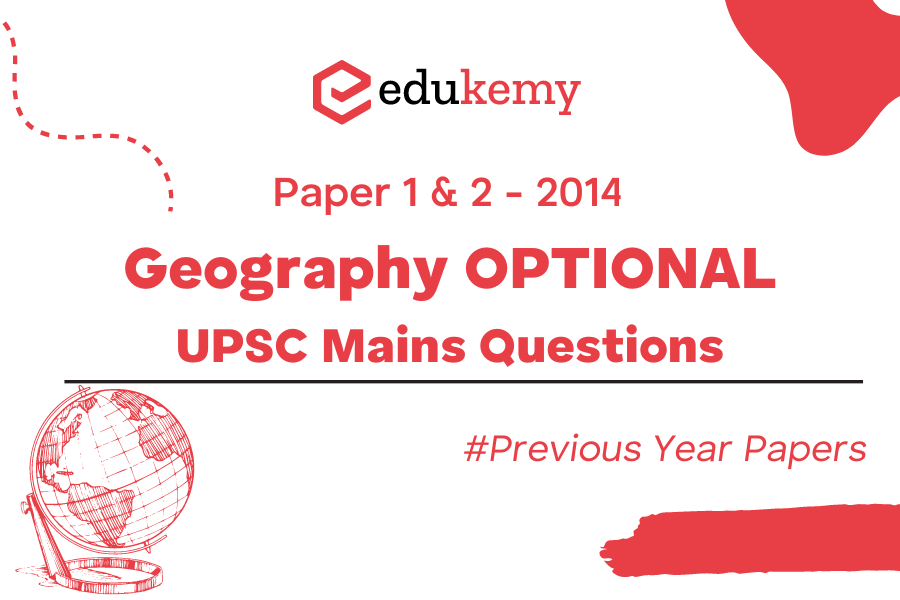The UPSC (Union Public Service Commission) Mains examination is a crucial stage in the highly competitive civil services examination in India. Among the array of optional subjects available to aspirants, Geography stands out as a popular choice due to its interdisciplinary nature and relevance to contemporary issues. Aspirants opting for Geography as their optional subject delve into a diverse range of topics, from physical geography and geomorphology to human geography and environmental studies. To understand the intricacies of the UPSC Mains Geography Optional Paper, analyzing previous year papers becomes indispensable. These papers serve as invaluable resources, offering insights into the exam pattern, question types, and the depth of knowledge required. In this context, delving into the previous year papers provides aspirants with a strategic advantage, aiding them in formulating a comprehensive preparation strategy to tackle the challenges posed by this esteemed examination.
Contents
- 1 Geography Optional Question Paper-1 (2014)
- 2 Geography Optional Question Paper-2 (2014)
- 2.1 SECTION A
- 2.2 SECTION B
- 2.3 Frequently Asked Questions (FAQs)
- 2.3.1 Q: How important is it to solve previous year papers for UPSC Mains Geography Optional?
- 2.3.2 Q: Are there any specific topics that are frequently asked in the Geography Optional papers?
- 2.3.3 Q: How can I effectively use previous year papers for revision?
- 2.3.4 Q: Are there changes in the pattern of Geography Optional papers in recent years?
- 2.3.5 Q: How can I manage time effectively during the Geography Optional paper in UPSC Mains?
- 2.4 To get free counseling/support on UPSC preparation from expert mentors please call 9773890604
Question Paper Specific Instructions
- Please read each of the following instructions carefully before attempting questions :
- There are EIGHT questions divided into two SECTIONS and printed both in HINDI and in ENGLISH.
- The candidate has to attempt FIVE questions in all.
- Questions no. 1 and 5 are compulsory and out of the remaining, THREE are to be attempted choosing at least ONE from each section.
- The number of marks a question/part carries is indicated against it.
- Answers must be written in the medium authorized in the Admission Certificate which must be stated clearly on the cover of this Question-cum-Answer (QCA) Booklet in the space provided. No marks will be given for answers written in a medium other than the authorized one.
- Word limit in questions, wherever specified, should be adhered to.
- Illustrate your answers with suitable sketches, maps, and diagrams. These shall be drawn in the space provided for answering the question itself.
- Attempts of questions shall be counted in chronological order. Unless struck off, the attempt of a question shall be counted even if attempted partly. Any page or portion of the page left blank in the answer book must be struck off.
Geography Optional Question Paper-1 (2014)
SECTION A
1. Answer the following in about 150 words each: 105=50
(a) Define the term ‘meander’ and describe the basic characteristics of entrenched meander and ingrown meander.
(b) Discuss the salient features of ‘sirocco’ and ‘mistral’.
(c) Give an account of the nature of biosphere as an ecosystem.
(d) State the uniquenes of the Eurasian Steppe Biome.
(e) Illustrate the origin and nature of Sargasso Sea and Lagoon.
2. (a) State the concept of plate tectonics. How does it help in explaining the formation of the Himalayas and Appalachian Mountains? 20
(b) Describe the origin and development of thunderstorms with examples. 15
(c) Enumerate the major causes of increasing degradation of environment in hills and hillslopes, and state its down-valley impact. 15
3. (a) Discuss the nature and origin of Indian monsoon and recent techniques of its prediction. 20
(b) Statetheconceptoferosionsurfacesandhighlihtthefactorsresponsiblefortheirdevelopment. 15
(c) Give a critical account of reasons and consequences of marine pollution. 15
4. (a) Explain weathering and mass wasting, and describe their geomorphic significance. 20
(b) Define zoogeographic region. Also describe the basic faunal makeup of the Neo-Arctic zoogeographic region. 15
(c) Give an account of recent observations on coral bleaching with reference to Clive Wilkinson’s Report. 15
SECTION B
5. Answer the following in about 150 words each: 10×5=50
(a) Elaborate the concept of mental map.
(b) Give an account of food security issues in developing countries.
(c) Discuss the factors responsible for counter-urbanisation.
(d) Explain the relevance of bottom-up and top-down approaches in the development of agrarian economy.
(e) Critically analyse application of models in Geography.
6. (a) Explain the necessary conditions of takeoff and subsequent stages of development of a nation as propounded by Rostow. 20
(b) Discuss environmental and economic problems associated with coal production. 15
(c) Discuss the contribution of geographers in the development of radical geography. 15
7. (a) Giving suitable examples, describe the importance of system analysis in geographical studies. 20
(b) “Rural sustainability is necessary for urban sustainability.” Discuss the statement in the backdrop of integrated development approach. 15
(c) “Indo-Gangetic hearth is considered to be one of the world’s richest cultural realms.” Examine. 15
8. (a) Explain the qualitative and quantitative methods of delineation of the sphere of urban influence. 20
(b) “World is passing through a global resource dilemma.” Comment. 15
(c) “Food productivity with purity of ecosystem is the need of the hour.” Elaborate. 15

Geography Optional Question Paper-2 (2014)
SECTION A
1. (a) On the outline map of India provided to you, mark the location of all the following. Write in your QCA Booklet the significance of these locations whether physical/ commercial/ economic/ ecological/ environmental / cultural, in not more than 30 words for each entry: 2×5=10
- Guru Shikhar
- Bhor Ghat
- Shravanabelagola
- Kalibangan
- Ganga Sagar
(b) Explain how eco-tourism activities could be important livelihood options in the Himalayan and North-Eastern regions of the country. (150 words) 10
(c) How is drainage pattern determined by the water divide? (150 words) 10
(d) Location of thermal power plants and coal fields in India are not mutually conducive. Analyse. (150 words) 10
(e) Why has agro and social forestry has failed to achieve its objectives? (150 words) 10
2. (a) Bring out the distribution of Laterite soils in India and their specific use for agriculture. 20
(b) Suggest the measures of wild-life conservation with reference to extinction of rare species. 15
(c) Describe the problems of agro-based industries in India in general and cotton textiles in particular. 15
3. (a) Highlight the socio-economic and ecological roles of River Cauvery in its riverine tract. 20
(b) Discuss the problems and prospects of National Waterway No. 1. 15
(c) Explain the concept of ‘Make in India’ and indicate the essential inputs for its success. 15
4. (a) Describe the salient climatological characteristics of Rayalaseema region. 20
(b) ‘In spite of various negative impacts of Green Revolution, there is a demand for New Green Revolution.’ Elaborate. 15
(c) What are the desired possible changes in our trade policy to promote the development of cottage industry? 15

SECTION B
5. (a) On the outline map of India provided to you, mark the location of all the following. Write in your QCA Booklet the significance of these locations whether physical/ commercial/ economic/ ecological/ environmental / cultural, in not more than 30 words for each entry: 2×5=10
- Mundra Port
- Chandipur
- Mahendragiri
- Hazira
- Vembanad Lake
(b) Highlight the implications of declining child sex ratio in India. (150 words) 10
(c) Analyse the feasibility of ‘Smart Towns’ Development in India. (150 words) 10
(d) Comment on the criteria of identifying Drought Prone Areas in India. (150 words) 10
(e) Bring out the role of terrain in determining India’s political influence over neighbouring countries. (150 words) 10
6. (a) Discuss the trends in emigration focusing on its major thrust. 20
(b) Account for the multiple problems of urban agglomerations. 15
(c) Evaluate the Backward Regions Grant Fund Programme. 15
7. (a) How can a meaningful skill development programme contribute to the economic growth of hill areas? 20
(b) Differentiate between the ‘intensity’ and ‘magnitude’ of an earthquake and explain its varying impact in different parts of India. 15
(c) Discuss the implications of India’s strategic location with reference to the Indian Ocean. 15
8. (a) India is involved in a number of border disputes. Explain the reasons and remedies. 20
(b) Discuss the concept of Command Area Development and evaluate its success with reference to Indira Gandhi Canal. 15
(c) How has an inappropriate urban land use policy accounted for undesirable development in and around metropolitan cities? 15
Frequently Asked Questions (FAQs)
Q: How important is it to solve previous year papers for UPSC Mains Geography Optional?
A: Solving previous year papers is crucial for UPSC Mains Geography Optional preparation. It helps candidates understand the exam pattern, question trends, and the depth of knowledge required. It also aids in time management and enhances problem-solving skills.
Q: Are there any specific topics that are frequently asked in the Geography Optional papers?
A: While the UPSC may vary questions, certain topics like geomorphology, climatology, human geography, and regional planning have consistently appeared in previous year papers. Candidates should focus on these areas, but also be prepared for any surprises.
Q: How can I effectively use previous year papers for revision?
A: Use previous year papers as a tool for self-assessment. Time yourself while solving papers to simulate exam conditions. Identify weak areas and revise those topics thoroughly. Analyze the answers critically, and understand the demand of the question to improve your answer-writing skills.
Q: Are there changes in the pattern of Geography Optional papers in recent years?
A: While the core syllabus remains consistent, the pattern of questions may evolve. UPSC may introduce interdisciplinary questions or focus on current affairs related to geography. Hence, staying updated with recent developments is crucial, and candidates should adapt their preparation strategies accordingly.
Q: How can I manage time effectively during the Geography Optional paper in UPSC Mains?
A: Time management is key in UPSC Mains. Practice writing answers within the stipulated time. Allocate time wisely among different sections. Start with questions you are most confident about to build momentum. Don’t spend too much time on a single question; move on and come back if time permits.
To get free counseling/support on UPSC preparation from expert mentors please call 9773890604
- Join our Main Telegram Channel and access PYQs, Current Affairs and UPSC Guidance for free – Edukemy for IAS
- Learn Economy for free- Economy for UPSC
- Mains Answer Writing Practice-Mains Answer Writing
- For UPSC Prelims Resources, Click here

